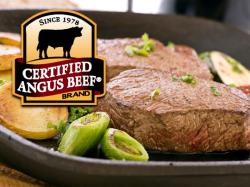Wholesale Beef Demand Sends Signals
December 31, 2012 | 4 min to read

Producing the most nutritious food in the world doesn’t count for much if you don’t have any buyers. Luckily for cattlemen who target high-quality beef, that’s clearly not an issue.
Those who purchase meat for foodservice and retail outlets say they want the highly marbled beef, because that’s what their customers want.
“We sell to people who are going to cook product and please guests—they’re not buying for themselves and they’re not shopping for price,” says Mort Kent, U.S. Foods of Denver, Colo. “They have a reputation to uphold and their customers expect consistency and quality, and they’re willing to pay for it.”
A recent analysis of Urner Barry wholesale beef pricing data supports that claim. During the two years from July 2010 to July 2012, the value difference between USDA Choice and Select grade beef was $62.31 on an average 830-pound (lb.) carcass.
The wholesale price for the Certified Angus Beef ® (CAB®) brand over Select was more than double that at $127.10 (see chart 1). That’s $15.31 per hundredweight (cwt.). The analysis is part of an updated “Black Ink Basics” technical report from CAB.
“I look at it that I am the purchasing agent for my customers, and so how can I do the best job for my accounts? Because I am really representing them,” says Franklin Hall, the third generation to operate Lone Star Foodservice, in Austin, Texas.
Just as a cattle buyer fills orders for a certain type and class of cattle, Hall acts on requests from his high-end restaurant clientele.
“My job as a processor and distributor is to make sure I am purchasing the best product at a fair price and when I receive that product the systems in our company are set up to respect that product—to properly age that product, to artfully cut that product and package and deliver it in a way that helps our customers and makes them look good.”
“Our goal is to have their guests have a wonderful eating experience,” he says.
If that means paying more for better beef, they’ll do it.
“We need to be able to have everyone in the chain of distribution make a little bit more on CAB than on a commodity product, otherwise it becomes a commodity product,” says Mark Polzer, vice president of business development for the brand.
That’s why distributors typically pass along that higher price they’ve paid to their customers.
“The foodservice market that we’re in is much more quality driven than it is price driven,” Kent says. “So producing the highest quality, most consistent beef with the best genetics is critically important.”
If farmers and ranchers answer that call, they’ll be rewarded, says Ted Schroeder, Kansas State University ag economist.
“Producers who sell fed cattle on a grid most directly and immediately benefit from added premiums associated with high-quality cattle,” he says.
Schroeder tracks USDA’s published “branded boxed-beef premium,” which is not as specific as the Urner Barry-reported number but shows a similar pattern (see chart 2). That number compared to the Choice weighted-average grid premium shows, “the two are highly positively correlated.”
“That means, as the wholesale premium for CAB increases, so does the producer’s premium for CAB fed cattle,” he says.
Schroeder estimates 64% of the wholesale premium for branded beef over Choice is passed back to the producer. Of course, he points out, those bonuses vary greatly from one grid to another.
Can that trend continue as beef prices inch higher?
“Generally higher beef and fed cattle prices tend to result in larger premiums for CAB cattle and beef,” Schroeder says. “If the recent pattern is an indicator of the probable future—and I think it likely is—then higher beef and fed cattle prices will translate into greater premiums for high-quality branded wholesale beef and CAB grid cattle.”
Meat buyers have already implemented creative solutions as a way to deal with higher prices. Kent says many chefs are lowering quantity, not quality.
“If you cut the portion size down by a couple of ounces and have a great starch and great vegetable to go with it, people will have been well fed, and they will leave with the memory of a great meal.” he says.
The fear that high-priced beef leads people to trade down while pinching-pennies is unfounded when the beef is good enough.
“To my knowledge, our beef packers do not have beef backing up in their coolers and warehouses. They are selling every single pound they produce, and so are we,” Kent says. “The customer demand is for higher quality, better marbled young cattle with consistent flavor, juiciness and tenderness.”
That helps explain CAB’s sixth consecutive record sales year in 2012, which Polzer also attributes to an “insurance policy” effect.
“CAB gives them the best chance to make money,” he says, “because of the additional quality assurance, the consistency that the product provides and ultimately the customer retention.”
Numbers at every level prove that marketing high-quality beef, whether on the hoof or on the plate, leads toward more profit.
For more information on this analysis, look for the Black Ink Basics technical summary, “Premium Prices Send Clear Signals,” at www.cabpartners.com/educators/index.php.
Source: Certified Angus Beef LLC
